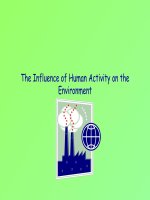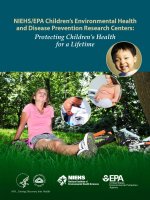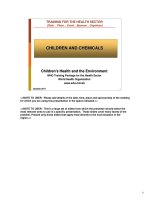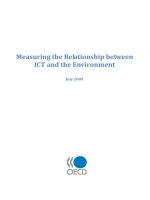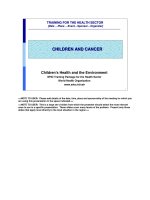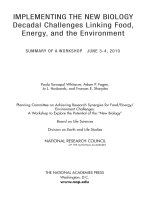Children''''s Health and the Environment ppt
Bạn đang xem bản rút gọn của tài liệu. Xem và tải ngay bản đầy đủ của tài liệu tại đây (3.08 MB, 68 trang )
1
TRAINING FOR HEALTH CARE PROVIDERS
TRAINING FOR HEALTH CARE PROVIDERS
[Date
[Date
…
…
Place
Place
…
…
Event
Event
…
…
Sponsor
Sponsor
…
…
Organizer]
Organizer]
Children's Health and the Environment
WHO Training Package for the Health Sector
World Health Organization
www.who.int/ceh
MERCURY
July 2008 version
<<NOTE TO USER: Please add details of the date, time, place and sponsorship of the meeting
for which you are using this presentation in the space indicated.>>
<<NOTE TO USER: This is a large set of slides from which presenters should select the most
relevant ones to use in a specific presentation. These slides cover all forms of mercury, their
sources and toxicities. Present only those slides that apply most directly to the local situation
in your region.>>
2
Mercury
Mercury
LEARNING OBJECTIVES
LEARNING OBJECTIVES
Health hazards associated with exposure to
the 3 different species of mercury (Hg)
How to diagnose and manage mercury
exposure and poisoning
Public health implications
How to prevent and reduce exposure
To understand, recognize and know
To understand, recognize and know
After this presentation, viewers should understand, recognize and know:
<<READ SLIDE>>
Mercury is a developmental toxicant whose effects have been known for many decades, but
concern has increased in the last few years among the medical and environmental
communities due to the recognition of its environmental ubiquity and persistence and the
developmental effects observed at relatively low levels of exposure.
In December 2002, the United Nations Environment Programme (UNEP) published a Global
Mercury Assessment, calling for immediate actions to reduce pollution. In May 2005, the first
Conference of the Parties (COP 1) proposed the inclusion of mercury into the group of the
Persistent Toxic Pollutants (PTPs).
Ref:
•UNEP. Global Mercury Assessment, December 2002:
www.chem.unep.ch/mercury/default.htm
3
Mercury
Mercury
MERCURY
MERCURY
Is persistent and cycles globally
Is persistent and cycles globally
Continues to be widely used
Continues to be widely used
Exposure has serious effects
Exposure has serious effects
Has an impact on global fishing
Has an impact on global fishing
May generate bigger problems in less
May generate bigger problems in less
-
-
developed regions
developed regions
Interventions can be successful
Interventions can be successful
UNEP. Global Mercury Assessment, December
2002: www.chem.unep.ch/mercury/default.htm
This slide states the main principles listed at the UNEP – Global Mercury Assessment, a
260-page document that responds to the specific requests made by UNEP's Governing
Council (GC) and that will be the basis for considering the possibility of an international
action.
UNEP: United Nations Environment Programme
Refs:
•UNEP. Global Mercury Assessment, December 2002:
www.chem.unep.ch/mercury/default.htm
•www.who.int/phe/news/Mercury-flyer.pdf
•www.who.int/water_sanitation_health/medicalwaste/mercurypolpap230506.pdf
•Children's Health and the Environment – A global perspective. A resource guide for the
health sector, WHO, 2005.
•American Academy of Pediatrics Committee on Environmental Health. Pediatric
Environmental Health, 2
nd
ed. Etzel RA, Ed. Elk Grove Village, IL: American Academy of
Pediatrics, 2003.
4
Mercury
Mercury
OUTLINE
OUTLINE
Environmental origin, transport and fate of 3
species
Routes of exposure
Toxicokinetics
Toxicodynamics
Target organs/systems
Treatment
Prevention
This presentation will cover the following topics:
<<READ SLIDE>>
<<NOTE TO USER: You may decide to delete certain parts of this outline if you are
giving a short presentation. Please change the outline accordingly.>>
5
Mercury
Mercury
ORIGIN: 1 ELEMENT
ORIGIN: 1 ELEMENT
–
–
3 SPECIES
3 SPECIES
Elemental
Elemental
Inorganic
Inorganic
Organic
Organic
Different
toxicity profiles
pearl1.lanl.gov/periodic/default.htm
Mercury is a heavy metal, an element, and therefore cannot be created or destroyed. Natural
sources of environmental emissions are volcanic eruptions, rock weathering and natural
combustion. As most metals, it can exist in different forms.
Each of its 3 forms: elemental (or metallic), inorganic (e.g. mercuric chloride) and
organic (e.g. methyl- and ethylmercury), have different toxicity profiles with different
implications for children's health and development.
Picture: pearl1.lanl.gov/periodic/default.htm
University of California, operator of the Los Alamos National Laboratory under Contract No.
W-7405-ENG-36 with the U.S. Department of Energy. Copyright Notice. For Scientific and
Technical Information Only. Copyright © 1998-2003 The Regents of the University of
California.
6
Mercury
Mercury
ENVIRONMENTAL SOURCES OF EXPOSURE
ENVIRONMENTAL SOURCES OF EXPOSURE
Chloralkali production
Artisanal gold and
silver mining
Mercury mining,
smelting and use
Burning fossil fuels
Waste incinerators
Volcanoes
Courtesy of Dr. Stephan Boese-O´Reilly 2003
Goldman, Pediatrics (2001) 108:197
<<READ SLIDE>>
Mercury has many uses, including manufacture of chlorine and caustic soda, gold and silver mining, mirror
production, dental amalgams, and manometers. It is released from mercury-mining and production sources, from
burning fossil fuels (especially rich in sulphur), from waste incineration (e.g. medical waste) incineration of corpses
(with amalgams) and it also may be released from volcanoes.
According to the UNEP report sources are grouped as:
•Natural sources releases due to natural mobilisation of naturally occurring mercury from the Earth's crust (e.g.
volcanic activity and weathering of rocks).
•Current anthropogenic (human activity-related) releases from the mobilisation of mercury impurities in raw
materials (fossil fuels: specially coal but also gas and oil).
•Current anthropogenic releases from mercury intentionally used in products and processes (releases during
manufacturing, leaks, disposal or spent products incineration).
•Re-mobilisation of historic anthropogenic releases previously deposited in soils, sediments, waters, landfills,
waste piles.
UNEP United Nations Environment Programme
Picture: Ball mill in Rwamagasa in Tanzania to grind the ore to extract gold from ore with mercury (Courtesy of Dr.
Stephan Boese-O´Reilly 2003)
Refs:
•Goldman LR et al. American Academy of Pediatrics Committee on Environmental Health: Technical Report:
Mercury in the environment: Implications for Pediatricians, Pediatrics (2001) 108:197
Mercury is a ubiquitous environmental toxin that causes a wide range of adverse health effects in humans. Three
forms of mercury (elemental, inorganic, and organic) exist, and each has its own profile of toxicity. Exposure to
mercury typically occurs by inhalation or ingestion. Readily absorbed after its inhalation, mercury can be an indoor
air pollutant, for example, after spills of elemental mercury in the home; however, industry emissions with resulting
ambient air pollution remain the most important source of inhaled mercury. Because fresh-water and ocean fish
may contain large amounts of mercury, children and pregnant women can have significant exposure if they
consume excessive amounts of fish. The developing fetus and young children are thought to be disproportionately
affected by mercury exposure, because many aspects of development, particularly brain maturation, can be
disturbed by the presence of mercury. Minimizing mercury exposure is, therefore, essential to optimal child health.
This review provides pediatricians with current information on mercury, including environmental sources, toxicity,
and treatment and prevention of mercury exposure.
•UNEP. Global Mercury Assessment, December 2002: www.chem.unep.ch/mercury/default.htm
7
Mercury
Mercury
MEDICAL WASTE
MEDICAL WASTE
Medical waste incinerators
~10% of all Hg air releases
Health care facilities
~5% of all Hg water releases
<<READ SLIDE>>
Refs:
•www.who.int/water_sanitation_health/medicalwaste/mercurypolpap230506.pdf
•www.epa.gov/ttncaaa1/t3/reports/volume2.pdf
8
Mercury
Mercury
-
-
Natural background
Natural background
-
-
Volcanic
Volcanic
-
-
Gold rush
Gold rush
-
-
World War II
World War II
-
-
Industrialization
Industrialization
Hg released in the last 100
Hg released in the last 100
years: 70% from human
years: 70% from human
activities
activities
A man made problem
A man made problem
Major atmospheric releases
Major atmospheric releases
detected in the ice core
detected in the ice core
Explanation of the chart:
"Atmospheric mercury deposition corresponds to volcanic and anthropogenic events over
the past 270 years. Preindustrial deposition rates can be conservatively extrapolated to
present time (4 ng/L; in green) to illustrate the increase during the past 100 years (in red)
and significant decreases in the past 15-20 years." (US Geological Service)
Most mercury in the modern environment comes from human activities and heavy industry.
Here is dramatic evidence that this problem of methylmercury contamination of our food is of
our own making. This composite ice core record from Wyoming, USA shows the dramatic
increase from baseline mercury levels (shown here in green) that have occurred due to
human activity. In fact, 70% of the mercury released in the last 100 years has been man
made (anthropogenic).
Ref:
•toxics.usgs.gov/pubs/FS-051-02/
9
Mercury
Mercury
A LARGE ENVIRONMENTAL PROBLEM
A LARGE ENVIRONMENTAL PROBLEM
In small scale gold mining areas Hg is used to extract
In small scale gold mining areas Hg is used to extract
gold from ore (amalgamation process)
gold from ore (amalgamation process)
1 to 2 kg of Hg are used to process 1 kg of gold
1 to 2 kg of Hg are used to process 1 kg of gold
Most Hg is released into the environment (soil, air,
Most Hg is released into the environment (soil, air,
water)
water)
More than 50% workers
More than 50% workers
have high levels
have high levels
…
…
and their children?
and their children?
© Stephan Boese-O´Reilly 2003
In Brazil, Guyana and in some other countries, gold mining that requires large amounts of
mercury is having tremendous consequences on the environment and the local community.
<<READ SLIDE>>
Ref:
•Agence France Presse, 26 October 2004.
"In the past two years, police have launched some 60 "Anaconda operations" named after
the giant boa constrictors that inhabit this tropical French overseas department but they
have not succeeded in squeezing the life out of the illegal gold trade that threatens the
environment here.
Instead, an estimated 12,000 workers, for the most part illegal workers from across the
border in Brazil, roam the rivers in search of the precious metal, poisoning the rivers with the
quicksilver they use to extract the gold. Their method could not be more simple, or more
brutal. From barges moored in the water, they pulverize the river banks with high-pressure
hoses, pump out the resulting slurry and amalgamate the tiny specks of gold with quicksilver,
or mercury.
Once the gold is extracted from the mercury, the highly toxic metal is dumped directly into
the river along with the slurry. "It is an ecological disaster,"… that brings in …the
deforestation and environmental devastation left in the wake of the gold-washers…
poisoning of the fish stocks, and consequently of the indigenous Indian population that
depends on the fish as a dietary staple.
The gold trade has brought with it some other curses of development, including malaria,
AIDS and various kinds of illegal trafficking…
… supplies needed by the gold-extracting business,… include … mercury. With the primitive
methods in use, it can take 1.3 kilos of quicksilver to process every kilo of gold, and it is
estimated that at least 10 tonnes of mercury are released into the environment every year.
The impoverished Brazilian panhandlers, many living in conditions of virtual slavery, are the
first victims of mercury vapor, which causes serious neurological defects. And according to a
study carried out as long ago as 1997, more than half the Indians living along the river have
excessive amounts of mercury in their organisms.
Picture: Liquid mercury used by miners to extract gold from ore in Tanzania (© Stephan
Boese-O´Reilly 2003)
10
Mercury
Mercury
Drasch , Wiley VHC, Verlag, 2004, all data in metric tonnes
300
300
-
-
100
100
Worldwide
~1900
~1900
170
170
110
110
130
130
30
30
1470
1470
Sum,
quantified
sources
1995
105
105
4.4
4.4
0.1
0.1
0.8
0.8
0.3
0.3
100
100
Australia
&Oceania
60
60
25
25
5.5
5.5
1.4
1.4
27
27
South
America
210
210
25
25
66
66
13
13
4.6
4.6
105
105
North
America
1075
1075
87
87
33
33
82
82
12
12
860
860
Asia
210
210
7.9
7.9
5.2
5.2
0.5
0.5
197
197
Africa
250
250
15
15
12
12
26
26
10
10
186
186
Europe
Sum
quantified
sources
Artisanal
gold
mining
Non-
ferrous
metal
production
Waste
disposal
Cement
production
Pig iron &
steel
production
Stationary
Combusti
on
Continent
11
Mercury
Mercury
AIR
Coal power plants
Waste incineration
Cement production
Chlor-alkali plants
Mining
ANTROPOGENIC
EMISSIONS
Volcanoes
Rock erosion
Fires
Whatever
NATURAL EMISSION
S
SOIL
WATER
Methylation
Plankton
Fish
Folk medicines
Cosmetics
Amalgams
Vaccines
OTHER POTENTIAL
SOURCES OF EXPOSURE
Mother and
Mother and
child
child
Picture: J. Pronczuk
12
Mercury
Mercury
TRANSPORT: GLOBAL CYCLE OF MERCURY
TRANSPORT: GLOBAL CYCLE OF MERCURY
Hg is emitted into
Hg is emitted into
the atmosphere
the atmosphere
and circulated
and circulated
globally
globally
EPA
When mercury is emitted into the atmosphere, it may deposit close to the source, or be
transported long distances, as shown in this diagram.
Picture: www.epa.gov/grtlakes/seahome/mercury/src/presmerc.htm (downloaded 2005)
The Environmental Protection Agency, Purdue University, and the Agricultural & Biological
Engineering Department.
(C) Copyright, 1996, 2003 by Purdue Research Foundation, West Lafayette, Indiana 47907.
All Rights Reserved. This material may be reproduced and distributed in its entirety for non-
profit, educational use, provided appropriate copyright notice is acknowledged.
13
Mercury
Mercury
TRANSPORT: GLOBAL CYCLE OF MERCURY
TRANSPORT: GLOBAL CYCLE OF MERCURY
EPA
Ultimately enters water bodies and deposits
Ultimately enters water bodies and deposits
Close to source
Long distance from source global pollution
Eventually, atmospheric mercury from mercury emissions ends up in water bodies where it
is methylated and bioconcentrated up the food chain. The major source of methylmercury for
most people is from eating contaminated fish.
High risk groups are the fetus and small children whose nervous systems are developing,
and women of child bearing age because of the exposure to the fetus.
•Main source: industrial emission
•Media: air and water
•Vector: fish
Picture: www.epa.gov/grtlakes/seahome/mercury/src/chemistr.htm (Downloaded 2005)
14
Mercury
Mercury
Hg in sediments
converts into
methylmercury
(MeHg)
MeHg enters the
aquatic food chain:
fish, marine and
freshwater
MeHg uptake by
humans through
fish consumption
Metabolic conversion and
Metabolic conversion and
bio
bio
-
-
accumulation
accumulation
through
through
“
“
food
food
-
-
chain
chain
”
”
FATE
FATE
EPA
For most people who are not occupationally exposed, fish is the major source of mercury
exposure.
Mercury attached to aquatic sediments is subject to microbial conversion to methylmercury
(MeHg).
Methylmercury enters the aquatic food chain, reaching highest concentration in “fish
eating fish” (e.g.tuna, sharks).
- Ocean fish high in methylmercury include mackerel, shark, swordfish, tile fish, large tuna,
grouper.
- Freshwater fish contamination depends more on local conditions but also is highest in long-
lived, predatory fish such as pike.
<<NOTE TO USER: Insert the list of local fish which are high in mercury>>
Methylmercury uptake by humans through fish consumption.
Ref:
•Clarkson TW et al, The toxicology of mercury – current exposures and clinical
manifestations, N Engl J Med, 2003, 349: 1731
Picture: www.epa.gov/grtlakes/seahome/mercury/src/aquatic.htm (Downloaded 2005)
The Environmental Protection Agency, Purdue University, and the Agricultural & Biological
Engineering Department.
(C) Copyright, 1996, 2003 by Purdue Research Foundation, West Lafayette, Indiana 47907.
All Rights Reserved. This material may be reproduced and distributed in its entirety for non-
profit, educational use, provided appropriate copyright notice is acknowledged.
15
Mercury
Mercury
ELEMENTAL
ELEMENTAL
(METALLIC) MERCURY
(METALLIC) MERCURY
–
–
"
"
QUICKSILVER"
QUICKSILVER"
Sources of exposure
Sources of exposure
Environmental:
Volcanic explosions, rock weathering, degassing
Anthropogenic inadvertent:
Combustion: fossil fuels (coal), waste incineration
Industrial: gold/silver mining, chloralkali plants, batteries,
switches, fluorescent lights, thermometers,
sphyngomanometers
Anthropogenic intentional:
Dental amalgams
Ritual and folk medicine use
Because of the complexity of mercury chemistry, it is often easier to discuss each species
separately. The following series of 6 slides recaps sources by species and briefly outlines
the common routes of human exposure, toxicokinetics and major systems damaged by
excess exposure.
<<READ SLIDE>>
Ref:
•Clarkson TW et al, The toxicology of mercury – current exposures and clinical
manifestations, N Engl J Med (2003) 349: 1731
16
Mercury
Mercury
Routes of exposure
Routes of exposure
Inhalation (volatile at room temp): 75-85% absorption
Ingestion and skin: almost no absorption
Elimination
Elimination
Urine and Feces
Toxicity
Toxicity
Lungs, eyes, gingival, skin
Also: central nervous system, kidneys, immune
system
ELEMENTAL
ELEMENTAL
MERCURY
MERCURY
<<READ SLIDE>>
Mercury vapour cannot be seen with the naked eye, but an educational video is
available to show how it elemental mercury vapourizes. To view the video go to
www.michigan.gov/mdch/0,1607,7-132-2945_5105_47868-181553 ,00.html
Refs:
•Casarett and Doull, Toxicology – The basic science of poisons. 5
th
Ed Ed: Klaassen., Mc-
Graw-Hill, 1996.
•www.michigan.gov/mdch/0,1607,7-132-2945_5105_47868-181553 ,00.html
17
Mercury
Mercury
Sources of Exposure
Sources of Exposure
Environmental
None
Industrial products
Disinfectants, antimicrobials
Alternative medicines, cosmetics
Vapor lamps, embalming
Photography
Latex paint (pre 1990s)
Example: mercuric chloride
INORGANIC
INORGANIC
MERCURY
MERCURY
<<READ SLIDE>>
Refs:
•Drasch G, Mercury in: Merian E, Anke M, Ihnat M, Stoeppler M (eds) Elements and their
compounds in the environment Vol 2., Wiley VHC Verlag, Weinheim, Germany, 2004
•Global Mercury Assessment. UNEP chemicals report Geneva 2002. www.chem.unep.chJ
•Kasznia-Kocot J et al. Domestic accidental mercury vapor intoxication in families. Public
Health (Oxf). 2008 Mar;30(1):113.
18
Mercury
Mercury
Routes of Exposure
Routes of Exposure
Ingestion - 10% absorbed
Skin - can be high and deadly
Elimination
Elimination
Renal
Toxicity
Toxicity
Primary: kidneys, gastrointestinal tract
Secondary: central nervous system
INORGANIC
INORGANIC
MERCURY
MERCURY
<<READ SLIDE>>
Refs:
•Clarkson TW et al, The toxicology of mercury – current exposures and clinical
manifestations, N Engl J Med (2003) 349:1731
•Drasch G, Mercury in: Merian E, Anke M, Ihnat M, Stoeppler M (eds) Elements and their
compounds in the environment Vol 2., Wiley VHC Verlag, Weinheim, Germany, 2004
•Global Mercury Assessment. UNEP chemicals report Geneva 2002. www.chem.unep.ch
19
Mercury
Mercury
Sources of Exposure
Sources of Exposure
Environmental conversion:
Fish and shellfish (e.g. methylmercury)
Industrial production:
Fungicides, bactericides (e.g. phenylmercury)
Vaccine preservatives (e.g thiomersal)
ORGANIC
ORGANIC
MERCURY
MERCURY
<<READ SLIDE>>
Refs:
•Clarkson TW et al, The toxicology of mercury – current exposures and clinical
manifestations, N Engl J Med (2003) 349: 1731
•Drasch G, Mercury in: Merian E, Anke M, Ihnat M, Stoeppler M (eds) Elements and their
compounds in the environment Vol 2., Wiley VHC Verlag, Weinheim, Germany, 2004
•Global Mercury Assessment. UNEP chemicals report Geneva 2002. www.chem.unep.ch
20
Mercury
Mercury
Routes of Exposure
Routes of Exposure
Gastrointestinal - rapid & complete absorption
Parenteral - 100% absorbed
Transplacental (concentrated in cord blood)
Elimination
Elimination
Feces - T
1/2
45 to 70 days in adults
Toxicity
Toxicity
Primary: central nervous system
Secondary: cardiovascular
ORGANIC
ORGANIC
MERCURY
MERCURY
Over 95% is absorbed from the GI (gastrointestinal) tract
Widely distributed to all tissues
•It crosses the placenta.
- Cord blood : Maternal blood – 1.7 (Mahaffey, 2004).
•It crosses the blood brain barrier.
- Active transport on L-methionine carrier.
-It is secreted in breast milk – but in very small amounts since most is bound to red blood
cells.
-It is degraded slowly by the human body.
-Half-life in adults is 45-70 days—Therefore, prospective mothers can significantly reduce
mercury body burden by avoiding exposure for 6-12 months prior to pregnancy.
- Excreted in feces.
-Builds up in the brain – duration many years.
Ref:
•Mahaffey KR et al, Blood organic mercury and dietary mercury intake: National Health and
Nutrition Examination Survey, 1999 and 2000, Environ Health Perspect. (2004) 112 (5): 562
21
Mercury
Mercury
CNS
Cardiovascular
FaecesIngestion
Parenteral
Transplacental
Fish
Fungicides
Preservatives
Organic
Organic
(methyl;
(methyl;
ethyl)
ethyl)
CNS
Kidney
GI tract
Skin (acrodynia
in children)
UrineIngestion
Dermal
Lamps
Photography
Disinfectants
Cosmetics
Folk medicine
Inorganic
Inorganic
(mercuric
(mercuric
chloride)
chloride)
CNS
Kidney
Lungs
Skin (acrodynia
in children)
Urine and
faeces
InhalationVolcanoes
Combustion
Waste
incineration
Thermometers
Amalgams
Folk remedies
Elemental
Elemental
(metallic)
(metallic)
Toxicity
Toxicity
Elimination
Elimination
Routes of
Routes of
exposure
exposure
Sources
Sources
Mercury
Mercury
This table summarizes the different sources of mercury, routes of exposure and elimination
and main effects.
<<NOTE TO USER: The relative importance of sources and particular species will vary
regionally. Please highlight what is most important in your region.>>
22
Mercury
Mercury
MERCURY: ACRODYNIA
MERCURY: ACRODYNIA
Uncommon syndrome "Pink disease"
:
Pain in the extremities
Pinkish discoloration and desquamation
Hypertension
Sweating
Insomnia, irritability, apathy
Considered as idiosyncratic reaction.
Courtesy of Professor Schwarz,
Acrodynia is a rare idiopathic chronic toxic reaction to elemental or inorganic mercury
exposure, which occurs mainly in young children. It is characterized by pain in the
extremities and pink discoloration with desquamation of the skin. Here are pictures of 2
children with acrodynia.
The top photo on the right side of the slide shows a child who is frequently crying, unhappy,
unwilling to walk, hence sitting in the buggy. The bottom photo shows a 2 ½ year old girl with
hypotonia and constant scratching. Notice that she has red lips, fingers, and soles of the
feet.
<<READ SLIDE>>
Ref:
•California Poison Control System, Poisoning and drug overdose, 3
rd
edition, ed: Olson,
Appleton and Lange, Connecticut, 1999
Pictures from:
Schwarz, Feersche Erkrankung (kindliche Akrodynie), Pädiatrische Praxis (1979) 21: 85 –
89. Used with permission (copyright: Hans Marseille Verlag GmbH).
Picture above: Frequently crying, unhappy, unwilling to walk, hence sitting in the buggy
(acrodynia).
Picture below: 2 ½ year old girl. Hypotonia, constant scratching, with red fingers, foot soles,
lips (acrodynia).
23
Mercury
Mercury
Courtesy of Professor v. Muhlendahl
Courtesy of Professor v. Muhlendahl
Miliary rash is typical of acrodynia. The photograph on the top shows Feer‘s Disease
(another term for acrodynia). Notice the scaling of the skin between the fingers. The
photograph on the bottom of the slides also shows Feer‘s Disease. Notice the exanthema,
which was due to mercury intoxication from a mercury thermometer broken in the children‘s
room four months previously.
Picture above: von Mühlendahl, Schulte-Wissermann, Grips, Hautveränderungen bei
Feer‘scher Krankheit. Pädiatrische Praxis (1995) 49, 647. Used with permission (copyright:
Hans Marseille Verlag GmbH).
Feer‘s Disease (acrodynia), scaling of the skin between the fingers.
Picture below: von Mühlendahl, Schulte-Wissermann, Grips, Hautveränderungen bei
Feer‘scher Krankheit. Pädiatrische Praxis (1995) 49, 647. Used with permission (copyright:
Hans Marseille Verlag GmbH).
Feer‘s Disease. Exanthema due to Hg intoxication from a mercury thermometer broken in
the children‘s room four months previously.
24
Mercury
Mercury
Courtesy of Professor Muhlendahl
These are more photographs of Feer‘s Disease (acrodynia) exanthema due to Hg
intoxication from a mercury thermometer broken in the children‘s room four months
previously. This photo was taken 3 weeks after the first pictures.
Picture above: v.Mühlendahl, Schulte-Wissermann, Grips, Hautveränderungen bei
Feer‘scher Krankheit. Pädiatrische Praxis (1995) 49, 647. Used with permission (copyright:
Hans Marseille Verlag GmbH).
Picture below: v.Mühlendahl, Schulte-Wissermann, Grips, Hautveränderungen bei
Feer‘scher Krankheit. Pädiatrische Praxis (1995) 49, 647. Used with permission (copyright:
Hans Marseille Verlag GmbH).
25
Mercury
Mercury
EXPOSURE IN
EXPOSURE IN
INDUSTRIALIZED
INDUSTRIALIZED
COUNTRIES
COUNTRIES
Methylmercury
Methylmercury
Consumption of contaminated fish & shellfish
Emitted to atmosphere by electric generation
Transplacental
Breast milk
Ethylmercury
Ethylmercury
Thiomersal
Elemental
Elemental
-
-
vapours
vapours
Traditional and folk medicine uses
Dental amalgam
The relative importance of sources of mercury exposure vary according to the country,
region, type of economic activity and level of development.
In the industrialized world, organic mercury exposure predominates in the form of
methylmercury from fish consumption. Additional exposures from vaccine preservatives
have substantially ceased since the late 1990s (this topic is covered later).
In some population groups, traditional uses of elemental mercury can lead to substantial
exposures.
Dental amalgams also contain mercury and can be a source of exposure. (This topic is
covered later).
The most critical period of vulnerability is prenatal. Small amounts of methylmercury can be
transmitted by breast milk, however, this is not sufficient in quantity as to outweigh the
benefits of breastfeeding (WHO strongly supports breastfeeding).
Once children are eating solid foods, dietary exposure from fish remains potentially
dangerous throughout postnatal neurodevelopment.
A recent analysis on public health and the economic consequences of methylmercury
toxicity to the developing brain concluded that "exposure to methylmercury emitted to the
atmosphere by American electric generation facilities causes lifelong loss of intelligence in
hundreds of thousands of American babies born each year and that this loss of intelligence
exacts a significant economic cost to American society, a cost that amounts to at least
hundreds of million dollars each year." (Trasande, 2005)
Refs:
•www.chem.unep.ch/mercury/Report/GMA-report-TOC.htm
•Trasande L et al. Public health and the economic consequences of methylmercury toxicity
to the developing brain, Environmental Health Perspectives (2005) 113 (5): 590
•American Academy of Pediatrics Committee on Environmental Health. Pediatric
Environmental Health, 2
nd
ed. Etzel RA, Ed. Elk Grove Village, IL: American Academy of
Pediatrics, 2003.


